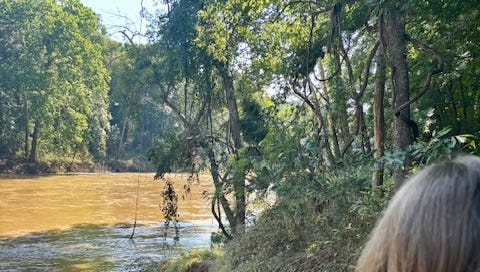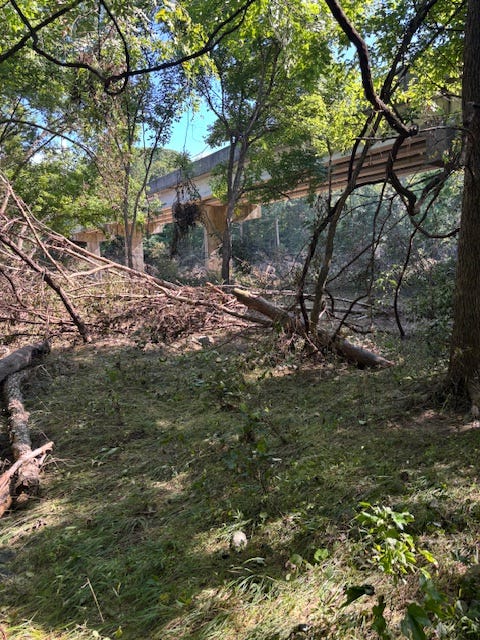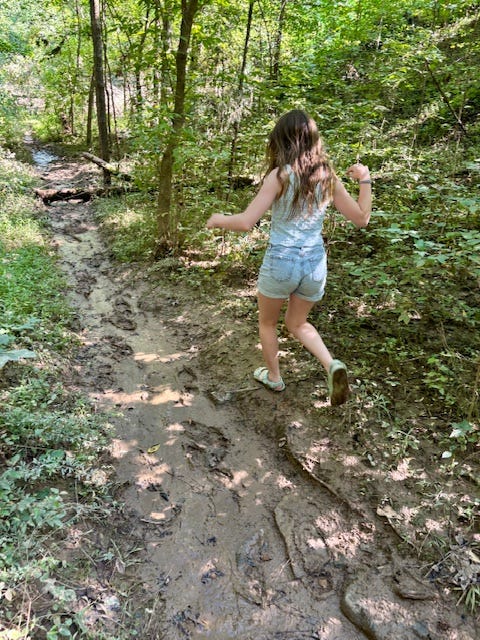Tropical Storm Chantal hit us last Sunday evening, knocking out power just after dinner. Rain fell through the night, nearly straight down, no wind, though our phones buzzed with tornado warnings.
Harriet was at a friend’s, Bea and Richard worked on a mystery game by candlelight, and I read until I fell asleep. We all slept fitfully. It just kept raining, and raining, and raining. We have a metal roof, and hard rains are often loud, but this one sounded like continuous buckets, dashed above our heads.
By the early morning the weather was calm. I could hear the distant, slow crunching of gravel as power trucks made their way across driveways washed onto the road.
I had enough phone battery to hear that our neighbors were all okay. I checked the USGS site and was honestly surprised it was still functional—not because of the storm, but because of DOGE.
In parts of Pittsboro, more than ten inches of rain fell overnight. Monday morning the Haw river crested above twenty-two feet—nearly a foot higher than its previous record, set in 1996 during Hurricane Fran. In Alamance County the river crested at 32 feet, and in Saxapahaw it swept over the bridge. Three people in Chatham County died in the floods. Power has been restored, but many roads are still closed, and Mebane and Hillsborough lost water services for a time. The riverbanks look eerie, the leaves painted a ghostly gray-brown, pawpaw trees bent as if still in the middle of a storm, high branches snapped—not from wind, but from water.
Harriet and I get up earliest on the weekends, so Saturday morning, nearly a week after the storm, we decided to walk to our usual swim spot just to see it. I realized we haven’t been swimming in the Haw this year! It rained so much this spring that just about every weekend we were home was unsafe. But we wanted to see the tree with the rope swing, the little beach where we spread our towels and take off our shoes before wading in.
The path to the river was coated in a thick, dark blanket of mud. It was also littered with fallen limbs and branches, and Harriet slipped and fell. She didn’t hurt herself, but she cried and said she wanted to go home. I asked if she’d still like to see the river—it was just a little farther. No, she insisted, she wanted to go home. I think the unfamiliarity of a familiar path scared her. She’s only seven—when she sees something scary, she wants to retreat to what is safe and known.
We walked home and made blueberry muffins with blueberries from In Good Heart Farm (the best CSA ever!). Later we went to the pool, and Bea and I decided to try again.
The path was still extremely muddy and slippery. “Oh my god,” Bea kept saying as we made our way to the riverbank. We saw fallen trees, trees completely uprooted, debris caught in upper branches. The silt-brown river rushed by. Protected from the current by a toppled tree, a small slider turtle poked its head out of the water.
Our familiar beach was underwater, and the banks were so eroded we wouldn’t have known it was our swim spot except for the rope swing hanging down.
“It’ll get better,” I told Bea, meaning the banks will green up again, the waters will be clear again.
“I have the feeling it won’t,” she said, meaning climate change.
That’s what age she is—old enough to know that there isn’t anywhere to retreat.
*
I can remember feeling anxiety when I was around Bea’s age that one day my community’s beloved woods and river would be transformed by development, no longer recognizable. It would be gone, my dad predicted, by the time I grew up. But that actually hasn’t happened yet. I was amazed, driving him to dialysis earlier this year, to see that King and Queen and Essex looked almost completely the same as I remembered.
But where we live is quickly changing, within the small and precious chunk of life that is our children’s childhood. Week by week, year by year, landscapes look different—logged, flattened, turned into new developments for houses that cost an unimaginable (to me) amount. Deforestation makes climate change worse, and climate change itself is changing the landscape, and our lifestyles.
I can’t believe we haven’t been swimming in the river! In 2025!
We’ll fix that, when it’s safe. Meanwhile we’re sharing tomatoes with our neighbors and getting our driveway put back where it should be.
*
A positive thing that Dreama Caldwell and Todd Zimmer pointed out, in their latest Down Home newsletter, is that on-the-ground electoral work and organizing also makes communities stronger and better-prepared to come together when disasters hit.
Down Home NC, Triangle Mutual Aid, and City Gate Dream Center are working together to directly assist with cleanup and recovery efforts in next-door Alamance County and Orange County, where housing and businesses were hit especially hard:
Chip in to Central NC’s flood recovery fund.
Anything you can give will go toward water, cleanup supplies, food, and housing support delivered directly to those in need. Of course there are also vast needs in Texas. Here is a good list of Texas-based mutual aid groups compiled by the Sierra Club.
Lots of love from us, Frog Troublers. We’re going pool swimming today with some friends, and later this week I’ll be in Atlanta for an AAUP meeting and training. More on that next time.









Thanks for sharing these pictures. I think it's good for us to all know what is really happening, first hand, in different parts of our state.
I live in Elkin. We have a creek that runs through our property. And I realized this week that we were already in mid-July, and the kids and I haven't even been to the creek for a walk/picnic/play in the water time. Granted, they're 20 and 17 now, not little anymore. But like you, part of the reason we haven't been down is because the weather this year has just been a little wackier than normal.
Thank you for raising girls who are in tune with the world around them.
Great to read that you are all okay. Enjoy the next stretch of summer!